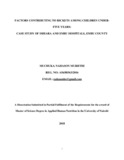Factors contributing to rickets among children under-five years: case study of Ishiara and Embu hospitals, Embu County

View/
Date
2018Author
Muchuka, Nahashon M
Type
ThesisLanguage
enMetadata
Show full item recordAbstract
Rickets is a significant problem which requires a special attention as Kenyan hospitals are continuing to record increased cases. The purpose of this study was to generate new knowledge on the factors that contribute to rickets in children under-five years old. The objective of the study was to determine the dietary intake of calcium, vitamin D and nutrition status as well as the exposure to sunlight practices and family planning methods used by the mothers in preconception period. A case control study was conducted among children under-five years old with and without rickets and their mothers seeking health services at Embu and Ishiara hospitals in Embu county. Data was collected using structured questionnaires and entered, cleaned and analysed using SPSS version 20. Weight for Height, Weight for Age and Height for Age Z-scores were used for nutrition assessment. Results showed that rickets was higher among households with family size of more than 4 members (p=0.012), children introduced early to complementary feeding (OR=2.5), consumption of low dietary intake of vitamin D and lack of exposure to sunlight (p=0.001, OR=9.8). Rickets was higher with decreasing duration of exposure to sunlight and among children who were fully dressed. The most frequently consumed vegetables by the children with rickets was spinach (91%) and those who consumed for more than three days in a week had higher likelihood of having rickets (OR = 2.5). Underweight (p=0.017), wasting (p=0.009) and Depo-Provera (p<0.001) predisposed children to rickets. Children from mothers who used Depo-Provera as method of family planning for more than one year during preconception period were more likely to have rickets (OR=15.5). In conclusion, demographic and socio-economic status, non-exposure to sunlight and poor exposure practices to sunlight, nutrition status and the type of family planning used by the mother in preconception period were predisposing factors to rickets
Publisher
University of Nairobi
